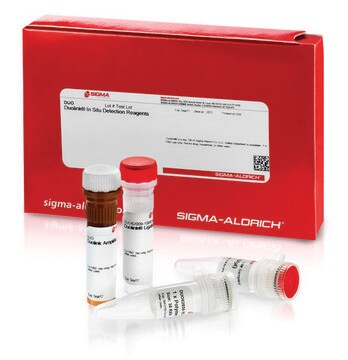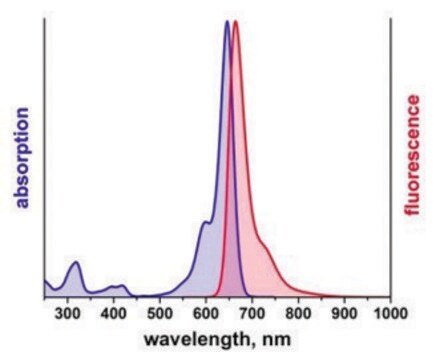DUO92012
Duolink® In Situ Detection Reagents Brightfield
Synonym(s):
in situ Proximity Ligation Assay reagent, Protein Protein Interaction Assay reagent
About This Item
Recommended Products
product line
Duolink®
packaging
pkg of Box A (-20°C)
pkg of Box B (2-8°C)
technique(s)
proximity ligation assay: suitable
suitability
suitable for brightfield
storage temp.
−20°C
Related Categories
Application
Follow the Duolink® In Situ Brightfield Protocol to use this product.
Visit our Duolink® PLA Resource Center for information on how to run a Duolink® experiment, applications, troubleshooting, and more.
To perform a complete Duolink® PLA in situ experiment you will need two primary antibodies (PLA, IHC, ICC or IF validated) that recognize two target epitopes. Other necessary reagents include a pair of PLA probes from different species (one PLUS and one MINUS), detection reagents, wash buffers, and mounting medium. Note that the primary antibodies must come from the same species as the Duolink® PLA probes. Analysis is carried out using HRP for brightfield detection.
Brightfield detection reagents are used for samples with significant autofluorescence.
Application Note
Two primary antibodies raised in different species are needed. Test your primary antibodies (IgG-class, mono- or polyclonal) in a standard immunofluorescence (IF), immunohistochemistry (IHC) or immunocytochemistry (ICC) assay to determine the optimal fixation, blocking, and titer conditions. Duolink® in situ reagents are suitable for use on fixed cells, cytospin cells, cells grown on slide, formalin-fixed, paraffin embedded (FFPE), or tissue (fresh or frozen). No minimum number of cells is required.
Let us do the work for you, learn more about our Custom Service Program to accelerate your Duolink® projects
View full Duolink® product list
Features and Benefits
- No overexpression or genetic manipulation required
- High specificity (fewer false positives)
- Single molecule sensitivity due to rolling circle amplification
- Relative quantification possible
- No special equipment needed
- Quicker and simpler than FRET
- Increased accuracy compared to co-IP
- Publication-ready results
Components
Box A:
- 5x Ligation - Contains oligonucleotides that hybridize to the PLA probes and all components needed for ligation except the Ligase
- 1x Ligase (1 unit/μL)
- 5x Amplification - Contains all components needed for Rolling Circle Amplification (RCA) except the Polymerase
- 5x Detection Brightfield - Contains oligonucleotide probes labeled with horseradish peroxidase (HRP) that hybridize to the RCA product
- 1x Polymerase (10 units/μL)
Box B:
- 1x Hydrogen Peroxide - Contains 0.3% hydrogen peroxide
- Substrate Reagents A-D - Contains all substrate components needed for HRP enzymatic reaction
- 1x Nuclear Stain - Contains Mayer′s hematoxylin solution for cell nuclei staining
Not included in Detection kit:
Primary antibodies, PLA probes, wash buffers, mounting medium
Other Notes
Store Box A and all of its components at -20°C. The enzymes should be kept cold (-20°C) at all times; Use a freezing block when removing them from the freezer.
Store Box B and all of its components at 2-8°C.
Legal Information
Signal Word
Danger
Hazard Statements
Precautionary Statements
Hazard Classifications
Acute Tox. 3 Dermal - Acute Tox. 4 Inhalation - Acute Tox. 4 Oral - Aquatic Chronic 3 - Eye Dam. 1 - Flam. Liq. 2 - Muta. 2 - Resp. Sens. 1 - Skin Irrit. 2 - Skin Sens. 1
Storage Class Code
3 - Flammable liquids
Flash Point(F)
42.8 °F
Flash Point(C)
6 °C
Certificates of Analysis (COA)
Search for Certificates of Analysis (COA) by entering the products Lot/Batch Number. Lot and Batch Numbers can be found on a product’s label following the words ‘Lot’ or ‘Batch’.
Already Own This Product?
Find documentation for the products that you have recently purchased in the Document Library.
Customers Also Viewed
Articles
Find Duolink references based on the type of method used, post translational modification detected, and research focus.
Support information including tips and tricks, frequently asked questions, and basic troubleshooting.
Things to consider for preparation, setup and execution of the Duolink® assay protocol
Protocols
This protocol describes the use of Duolink® PLA reagents for the brightfield detection, visualization, and quantification of individual proteins, protein modifications, and protein interactions in tissue and cell samples.
Related Content
Applications to detect, quantify and visualize protein-protein interactions, post-translational modifications and low expression protein detection using proximity ligation assay
Our team of scientists has experience in all areas of research including Life Science, Material Science, Chemical Synthesis, Chromatography, Analytical and many others.
Contact Technical Service












